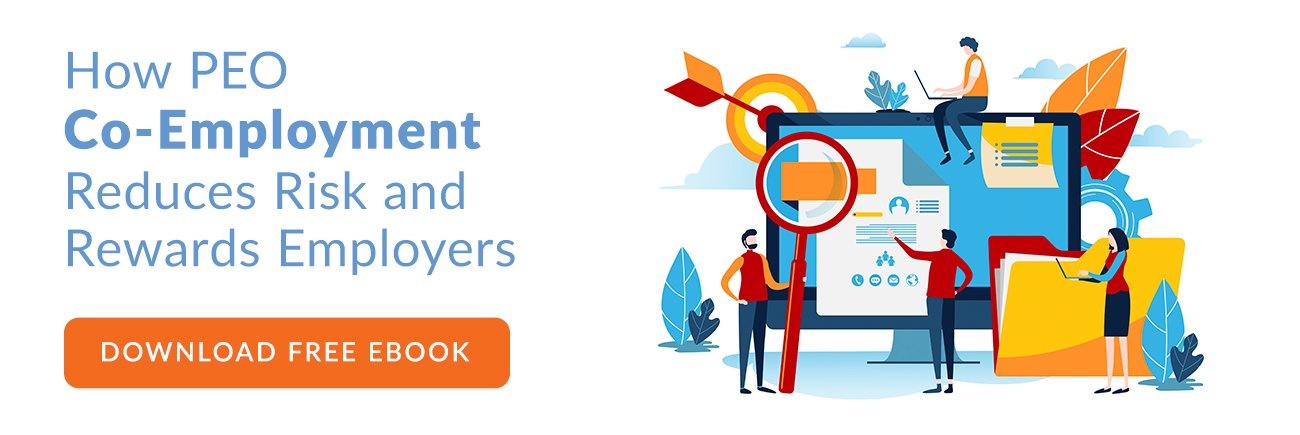According to the National Association of Professional Employer Organizations (NAPEO), Professional Employer Organizations (PEOs) provide services to approximately 175,000 small and mid-sized businesses that employ more than 3.7 million people. Ninety-eight percent of small businesses partnered with a PEO would recommend a partnership to another small business owner.
However, the increasing popularity and prevalence of PEO partnerships have created misconceptions about the role of employers in the partnership. Some executives worry about losing operational control in a PEO partnership.
This simply is not true.
However, the confusion is understandable. It stems from a misunderstanding of co-employment model and the concept of "employer of record." Understanding who the employer is in a PEO partnership requires understanding co-employment.
What Is Co-employment?
PEO co-employment is an employment arrangement in which a business owner and the PEO split employment responsibilities. The PEO takes care of administrative tasks and duties, while the owner deals with running their business on a day-to-day basis.
The co-employment relationship means the PEO files the business's payroll taxes under the PEOs federal employer identification number (FEIN). This makes the PEO the employer of record for the IRS because they use their FEIN number instead of the businesses' FEIN number. This allows the PEO to remit payroll taxes for their client's business.
The exact terms of a PEO partnership vary, but the most important thing to remember is that co-employment is different from joint employment.
With joint employment, both parties can make day-to-day decisions such as hiring and firing. This is not true of a co-employment relationship like those involved in PEO partnerships. The client business never has to give up any employer responsibilities they want to keep.
PEOs are never in charge of day-to-day operations or terminating employees. Instead, they serve as trusted advisors when issues arise related to termination or employee disputes.
In most partnerships, employers use a PEO to take on administrative and human resource-related tasks so they have free time to focus on activities that grow sales. Some examples of services PEOs provide for their client businesses include:
- Provision of employee benefits
- Unemployment, workers' compensation, and benefits administration
- Payroll processing and withholdings
- 401(k) Retirement plans with reduced fees
- Workers' compensation administration when an accident or injury occurs in the workplace
- Helping businesses comply with labor and employment laws and regulations
- Assistance with employee onboarding, training, and development
Ultimately PEO partnerships are customizable to the needs and wants of a business. At the very least, most businesses that strategically partner with a PEO do so to provide less costly benefits to their employees and let the PEO handle payroll-related tasks. However, businesses can request their partnership includes all the services listed above.
What Is the Employer of Record?
A PEO partnership means the PEO is the employer of record. This designation has no relationship with the day-to-day decision-making of the business. It simply shifts the responsibility to remit payroll taxes from the business owner to the PEO, who must remit them on behalf of their client. This also puts the tax liability and risk on the PEO without shifting any control over employees or daily operations.
Having a PEO as the employer of record can be especially beneficial for companies that intend to expand their business. As an employer of record, PEOs are responsible for keeping abreast of the tax codes that apply to their clients, saving business owners the time and headache of dealing with tax compliance.
Who Is the Employer?
When the Internal Revenue Service (IRS) looks at tax filings and other paperwork, they will consider the PEO the employer. However, from a functional and practical standpoint, the PEO and the client are employers in a PEO partnership, a co-employment agreement. Employees who work for the business will still answer to the business owner, but they may see the PEO's name on d human resource-related documents.
At the end of the day, the answer to "Who is the employer?" depends on what employer responsibilities are being talked about. Executives remain the employer when it comes to steering the company and making decisions that impact operations. The PEO is only the employer for remitting payroll taxes and the duties surrounding tax records.



